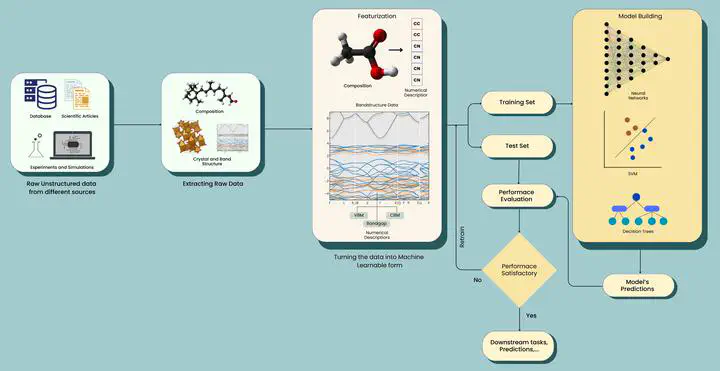Machine Learning driven Materials Discovery

Scientific Challenge
Discovering functional materials with targeted properties is critical for technological advancement, but the vast chemical composition space and complex structure-property relationships make this task extremely challenging. Traditional approaches, including trial-and-error experiments and exhaustive ab initio calculations, are time-consuming and resource-intensive, limiting exploration and slowing the pace of discovery.
However, purely data-driven approaches risk sacrificing physical insight for predictive accuracy. A central challenge is therefore to develop methods that efficiently predict material properties while maintaining interpretability and scientific understanding, ensuring that predictions are physically grounded and experimentally actionable.
Our Approach
We leverage Machine Learning (ML) integrated with DFT validation to accelerate materials discovery through physics-informed, interpretable models:
- Identify patterns and correlations in chemical and structural datasets to predict material properties rapidly
- Develop hybrid ML approaches that combine predictive power with physical interpretability, mapping feature vectors to meaningful descriptors
- Validate ML predictions through targeted DFT calculations and high-throughput screening
- Apply ML systematically across defect-host systems for qubits, catalytic materials for hydrogen evolution, and functional alloys
We explicitly prioritize physical interpretability over marginal gains in predictive accuracy, ensuring that machine-learning models serve as tools for scientific understanding rather than black-box optimizers detached from materials physics.
Key Insights & Achievements
- Designed ML models targeting defect-host systems for quantum information processing, specifically defects analogous to nitrogen-vacancy (NV) centers in diamond
- Achieved F1 scores > 0.98 and Matthews correlation coefficients > 0.90 on imbalanced datasets while maintaining model interpretability
- Predicted materials suitable for building qubit arrays with long coherence times at room temperature, providing a roadmap for experimental validation
- Applied interpretable ML frameworks to accelerate screening of catalytic materials and compositionally complex alloys, identifying physically plausible candidates for targeted validation
Collectively, these results establish a mechanism-aware approach to ML-driven materials discovery, where predictive models reveal governing descriptors and guide experimental synthesis rather than replace first-principles understanding.